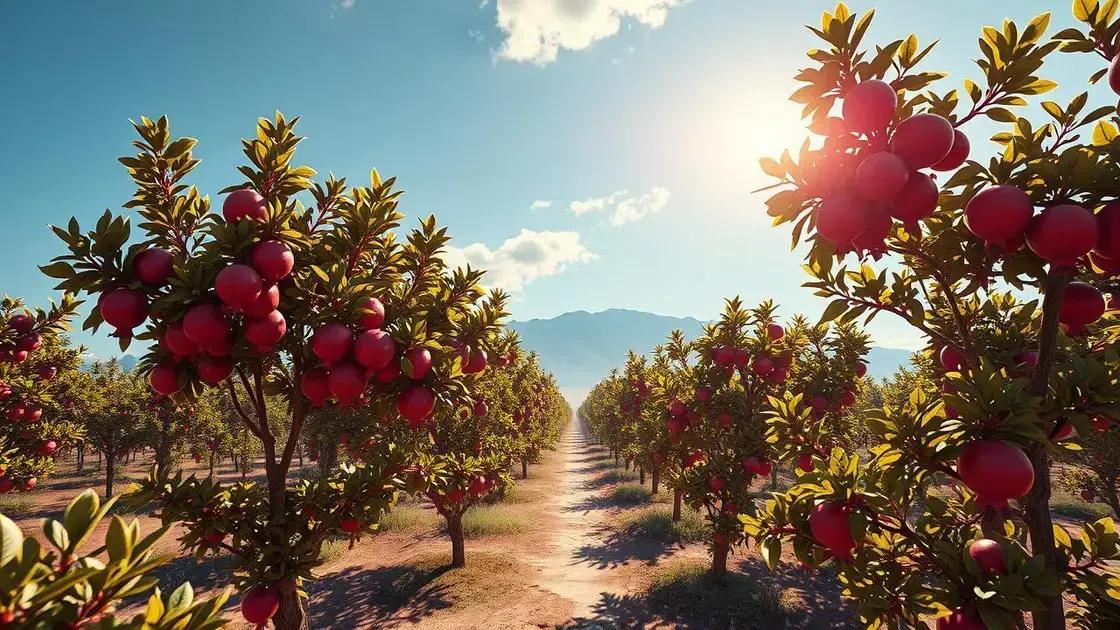How to Care for a Pomegranate Plant: 7 Essential Tips for Success
How to care for a pomegranate plant is not just about watering and sunlight; it’s a journey into nurturing a fruitful life. Not every garden naturally caters to the needs of these spectacular plants. With the right knowledge, you’ll uncover the secrets that lead to a vibrant pomegranate plant, ready to reward you with bountiful fruit. Let’s dive into the essential tips that make all the difference.
Table of Contents
ToggleTop watering techniques for your pomegranate plant
Top watering techniques for your pomegranate plant are essential for promoting healthy growth and maximizing fruit production. Understanding how much water your pomegranate plant needs, and when to provide it, can make a significant difference in its development.
Understanding water needs
Pomegranate plants thrive in well-drained soil but need adequate moisture for optimal growth. The key is balancing between overwatering and allowing the soil to dry out. Here are some tips:
- **Soil moisture monitoring**: Use a moisture meter to check the soil dampness.
- **Signs of overwatering**: Look for yellowing leaves or root rot.
- **Signs of underwatering**: Check for wilting leaves and dropped fruit.
Optimal watering schedule
To ensure your pomegranate plant receives the right amount of water, follow this watering schedule:
- **Young plants** (0-1 year): Water every 7-10 days, especially during dry spells.
- **Established plants** (1 year+): Water every 10-14 days, depending on rainfall.
- **During fruit development**: Increase watering frequency to support growing fruits.
Best watering methods
Employ appropriate watering techniques to maintain soil health and moisture levels:
- **Drip irrigation**: This method delivers water directly to the roots and helps reduce evaporation.
- **Soaker hose**: Lay a soaker hose on the soil surface to give gentle moisture over a longer period.
- **Hand watering**: Ensure even distribution by watering slowly around the base of the plant.
Additional tips for effective watering
Consider these extra strategies to keep your pomegranate plant thriving:
- **Watering time**: Early morning is the best time to water, as it reduces evaporation and fungal diseases.
- **Mulching**: Apply organic mulch around the base of the plant to maintain soil moisture and regulate temperature.
- **Seasonal adjustments**: Alter your watering schedule with changes in temperature and rainfall.
For more information on soil considerations absolutely vital for your plants, take a look at exploring indoor gardening techniques.
Conclusion on watering practices
Implementing these top watering techniques will help your pomegranate plant flourish in various conditions. Monitoring moisture levels, developing a watering schedule, and employing the best watering methods are all key components in becoming a proficient gardener.
Optimal sunlight requirements for thriving pomegranate trees

Optimal sunlight requirements for thriving pomegranate trees are crucial for ensuring healthy plants and fruitful yields. Understanding how much sunlight your pomegranate trees need can significantly impact their growth and productivity.
Understanding sunlight needs
Pomegranate trees thrive in bright, direct sunlight. Here’s what you should know about their sunlight preferences:
- **Full sun**: Ideally, pomegranate trees require at least 6 hours of direct sunlight daily.
- **Partial shade**: While they can tolerate some shade, this may hinder fruit production.
- **Sun exposure**: South-facing locations are best for maximum light absorption.
Signs of insufficient sunlight
It’s important to recognize the symptoms of inadequate sunlight:
- **Stunted growth**: Trees may not reach their full height or spread.
- **Leaf drop**: Leaves may turn yellow and fall off.
- **Poor fruit set**: Lack of sunlight can lead to fewer pomegranates.
Creating the ideal environment
To ensure your pomegranate trees receive the right amount of sunlight, consider these key strategies:
- **Choose the right location**: Plant trees in an open area that gets unobstructed sun.
- **Prune surrounding foliage**: Keep nearby plants trimmed to prevent shading.
- **Rotate pots**: For potted trees, rotate them regularly for even sunlight distribution.
Seasonal considerations
Adapt your care based on seasonal changes to sunlight availability:
- **Spring**: Encourage growth as days lengthen and sunlight increases.
- **Summer**: Monitor hydration, as heat can stress your trees despite ample light.
- **Fall**: Prepare for shorter days by ensuring trees are in optimal light spots.
For additional insights into soil and gardening practices, check out exploring indoor gardening techniques. Understanding your trees’ needs holistically will help in creating the best conditions for success.
Conclusion on sunlight needs
Providing optimal sunlight for pomegranate trees is essential for thriving plants and abundant fruit. By understanding their specific sunlight requirements and creating the right conditions, you can set your trees up for a bountiful harvest.
Essential fertilizing practices for pomegranate plants
Essential fertilizing practices for pomegranate plants are crucial for promoting robust growth and ensuring a plentiful harvest. Understanding how and when to fertilize can make a significant difference in the health of your pomegranate trees.
Why fertilizing is important
Fertilizing provides essential nutrients that help pomegranate plants grow strong and produce abundant fruits. Here’s why you should prioritize fertilization:
- **Boosts growth**: Proper fertilization encourages healthy growth and increases fruit yield.
- **Improves soil health**: Nutrients replenish the soil, enhancing its quality for future planting.
- **Promotes resilience**: A well-fertilized plant is more resistant to diseases and stress.
Choosing the right fertilizer
Selecting the appropriate fertilizer is essential for optimal results. Here are some options:
- **Organic fertilizers**: Compost and well-rotted manure enhance soil structure and provide nutrients.
- **Chemical fertilizers**: Look for NPK fertilizers with a balanced ratio, such as 10-10-10.
- **Liquid fertilizers**: These can be applied during the growing season for quick nutrient absorption.
When to fertilize
Timing your fertilization is just as important as the type of fertilizer used. Consider the following schedule:
- **Early spring**: Fertilize as new growth begins to support development.
- **After fruit set**: Apply a second round of fertilizer to enhance fruit growth.
- **Late summer**: A final application can help prepare the plant for winter dormancy.
Application techniques
How you apply fertilizer can affect its effectiveness. Here are some tips:
- **Spread evenly**: Distribute fertilizer evenly around the root zone to prevent burning.
- **Water in**: Ensure you water after application to help dissolve the nutrients into the soil.
- **Avoid root contact**: Keep fertilizers away from the roots to prevent damage.
For a deeper understanding of soil specifications and best practices, check out exploring indoor gardening techniques. This can further enhance your fertilizing practices.
Conclusion on fertilizing pomegranate plants
By implementing essential fertilizing practices, you can ensure your pomegranate plants stay healthy and productive, leading to a bountiful harvest at the end of the growing season.
In conclusion
To ensure the health and productivity of your pomegranate plants, implementing proper care techniques is essential. From understanding optimal sunlight requirements to mastering effective watering and fertilizing practices, each aspect contributes to your plant’s success. As you nurture your pomegranate trees, remember the importance of monitoring their needs and adjusting care accordingly. By following these guidelines, you can enjoy a flourishing garden filled with delicious, ripe pomegranates. For more valuable information, check out tips on enhancing your indoor garden.

